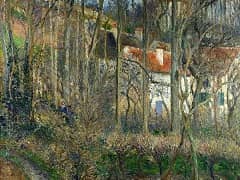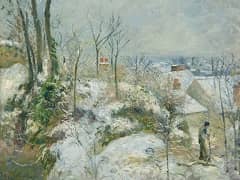Kitchen Garden with Trees in Flower, Spring, Pontoise, 1877 by Camille Pissarro

The titles of Pissarro's paintings are very rarely specific. They usually consist of a general description and a location. The detailed title for The Red Roofs, Corner of a Village, Winter, which appears to be original , must therefore be significant. It appears that Pissarro chose to paint the roofs on the Cotes Saint-Denis just when they had recently been retiled. Their distinctive colour obviously made a strong impression on him; he has not merely reproduced them but studied their redness in relation to that of the bushes, earth and ground around them. Red Roofs is a study in red.
Colour, and the technique with which it has been applied, is also significant in Kitchen Garden with Trees in Flower. Rather than dragging the paint along the canvas to create a smooth surface, Pissarro has quickly applied his brush, heavy with individual colours, to form dashes of pure pigment. The build-up of paint caused by this technique is so thick in parts, particularly in the white blossom, that it stands out in relief from the surface of the picture.
The structure for the composition of this painting is one developed and explored by Pissarro mainly at the end of the 1870s. Through a screen of trees, which makes an interesting pattern in the foreground, the shapes of houses can be glimpsed in the background. Pissarro used this formula in many works painted around Pontoise at this time, including a river scene. It was a traditional theme explored by Daubigny and particularly Gustave Courbet in his forest scenes, but Pissarro - and indeed Claude Monet and other members of the Impressionist group - were drawn to the abstract pattern made on the surface of the painting by a screen of trees, drawing the eye of the viewer into its depths and on to the scene beyond. Monet in similar scenes went on to abstract the screen of trees even further.
Cezanne, who on a number of occasions worked with Pissarro at Pontoise in the 1870s and 1880s, also painted this exact scene. There is no doubt that he assembled his easel next to Pissarro's and that the two artists worked side by side.
















